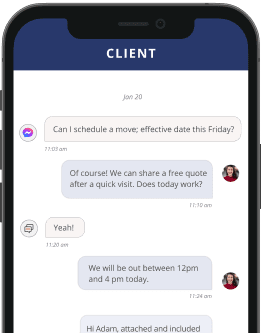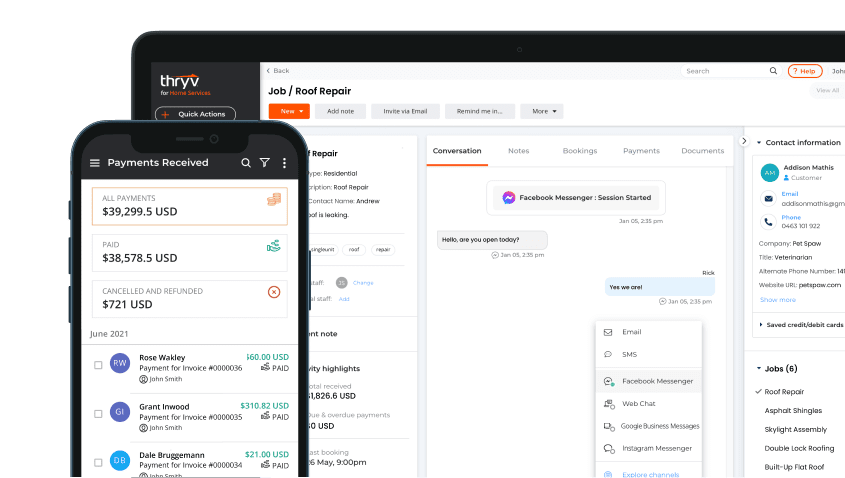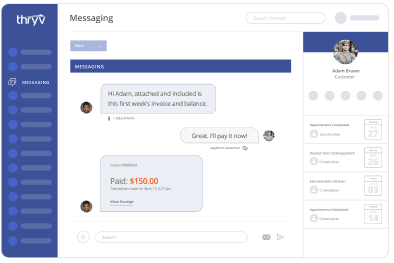Pricing your electrician services is one of the most important decisions you’ll make when running your business. The right electrician pricing strategy affects everything — from how many jobs you win, to how profitable those jobs are, to whether your electrical business services can grow steadily over time.
Many electricians struggle with balancing affordability for customers and profitability for themselves. The key is to find a clear, consistent approach that reflects your costs, highlights your value, and builds trust. Whether you’re new to the trade or have years of experience, learning how to price electrician services the right way will help you attract more work, protect your bottom line, and strengthen your reputation.
Here’s how to set competitive prices for your electrician business:
Get clear on your true costs
Before you can create your prices, you need a full picture of what it really costs to run your business. Skipping this step can leave you undercharging and struggling to stay profitable. Break your costs into three main categories:
- Direct costs: These are the expenses tied directly to each project, such as wiring, outlets, fixtures, permits, and protective gear. Tracking direct costs closely ensures you’re not absorbing expenses that should be passed along to the customer.
- Labor costs: Factor in your own time as well as the wages of any employees or subcontractors. Be sure to include payroll taxes, insurance, and benefits. If you’re just starting an electrician business, don’t undervalue your time — it’s the largest single driver of profitability in electrical business services.
- Overhead costs: These are the behind-the-scenes expenses that keep your company running, like vehicle fuel and maintenance, new tools, licensing fees, advertising, and utilities. Even subscriptions for software or job management systems should be part of this total. Spreading overhead across your pricing helps you cover the true cost of staying in business.
Getting a handle on these three areas allows you to calculate a baseline for your pricing strategy. Once you know your break-even point, you can confidently set rates that lead to steady profit instead of guesswork.
Decide how you’ll charge for your work
Once you know your costs, the next step is choosing a pricing model that makes sense for both you and your customers. There’s no single “right” approach to electrician pricing — the best option depends on the type of work you do most often and how your customers prefer to pay.
- Hourly rate: This model charges customers based on the time you spend on the job. It’s straightforward and flexible, which makes it a good fit for troubleshooting or projects where the scope isn’t clear at the start. The challenge is that customers may feel uneasy about not knowing the final cost. To ease those concerns, many electricians provide an estimate upfront, then update the customer if the work takes longer than expected.
- Flat-rate pricing: With this approach, you set a fixed price for specific services, like installing outlets, upgrading panels, or rewiring a room. Customers like the certainty of knowing the cost before you start, and it also allows you to charge for your expertise rather than just your time. Flat-rate pricing can improve efficiency too, since your speed and experience directly benefit your bottom line.
Some electricians find the best balance is a combination of both. For example, you might use an hourly rate for diagnosing electrical issues but switch to flat-rate pricing for repairs or installations once you know the solution. This blended approach gives customers clarity while still protecting your profit margins.
Study your local market before setting rates
Even with a clear picture of your costs, your electrician pricing strategy also needs to reflect what customers in your area are willing to pay. If your rates are far above or below the local average, you risk losing jobs or leaving money on the table. Market research helps you strike the right balance and position your electrical business services as both competitive and professional.
- Check competitor websites and listings: Browse the websites of other electricians in your area, as well as their Google Business Profiles and directories like Yelp or Angi. Pay attention to how they describe their services, what they highlight as part of their value, and how their pricing is presented.
- Read customer reviews carefully: Reviews often contain indirect pricing insights. Customers might say things like, “The price was fair for the work,” or “They were more expensive than others, but worth it.” These comments help you understand how your market views value, not just raw costs.
- Network with peers and trade groups: Industry associations, apprenticeships, or local trade networks can provide benchmarks for fair pricing. This can be especially helpful if you’re exploring electrician lead generation opportunities or trying to attract larger projects.
Add a profit margin that supports growth
After you’ve calculated your costs and researched the market, the next step is building in a profit margin. This is what keeps your electrical business services sustainable and allows you to invest in new equipment, training, and marketing.
- Markup range: Many electricians add between 20% and 50% to cover profit, depending on the complexity of the job and local demand. For high-skill projects like panel upgrades or generator installations, margins on the higher end are common.
- Why it matters: Without a margin, you’re simply covering expenses — not creating the income needed to grow or weather slower seasons.
- Flexibility: Margins don’t have to be fixed. You may decide to apply higher markups to specialized services while keeping basic jobs more competitive.
Thinking through profit margins carefully ensures you’re not just surviving — you’re building a business that can thrive for years.
Communicate value, not just price
Customers rarely hire an electrician based on price alone. In fact, many are willing to pay more if they trust your skills, reliability, and professionalism. When explaining your pricing, focus on the value you provide:
- Licensed work and certification: Customers want to know the work is safe and meets all codes. Highlighting your electrician certification and credentials helps justify your rates.
- Reliable scheduling and professional communication: Show customers that you’ll arrive on time, stay in touch, and respect their schedule. That peace of mind is worth paying for.
- Clear estimates, easy invoices, and digital payment options: Customers appreciate transparency and convenience. Offering straightforward estimates and modern payment choices helps them feel confident in moving forward and makes it easy to do just that.
When you position your services this way, you make it clear you’re not just another contractor — you’re a trusted professional providing long-term value. That difference is often what wins the job, even if your pricing isn’t the lowest.
Keep your pricing consistent and professional
Consistency in electrician pricing is one of the simplest ways to build trust with customers. If two people in the same household get different quotes for the same work, or if your invoices look unclear, confidence in your business can take a hit. That’s why it’s so important to keep your pricing steady and your process professional.
- Use digital tools for estimates and invoices: Sending polished estimates that can be approved with a few clicks shows customers you’re organized and transparent. Once the job is done, you can convert those estimates into invoices without retyping everything, which reduces mistakes.
- Track payments in one place: Having a system that records who has paid, who is overdue, and what’s still pending saves you time and prevents awkward conversations. Clear payment tracking also helps you plan your cash flow.
- Maintain uniform pricing: Whether it’s an emergency call or a routine repair, make sure your pricing structure is consistent across your electrical business services. This doesn’t mean you can’t charge more for after-hours work, but it does mean your approach should be fair and predictable.
Staying organized this way not only makes running your business easier — it also reassures customers that they’re working with a professional who values accuracy, transparency, and fairness.
How Thryv can help
Thryv®’s comprehensive software was built to help small businesses market, sell, and grow. For electricians, it simplifies nearly every step of pricing and payment:
- Create and send estimates: Build professional estimates quickly, then convert them into invoices once the job is complete.
- Streamline invoicing and payments: Offer customers digital payment options, send reminders, and reduce late payments.
- Centralize communication: Keep customer conversations in one place so nothing falls through the cracks.
- Manage scheduling: Sync your calendar with customer appointments to avoid conflicts.
Beyond pricing and payments, Thryv also helps you run your electrical business services more smoothly. You can manage online listings to ensure your contact details are accurate everywhere customers search, monitor and respond to reviews to build credibility, and even track your marketing so you know which efforts are generating the most leads. These tools keep your business organized, professional, and easy for customers to find and trust.
By reducing paperwork and automating repetitive tasks, Thryv’s digital electrician tools give you more time to focus on delivering quality electrician services.
Free pricing tools
In addition to its software for electricians, Thryv also offers free tools to help you run your business smarter. These tools make it easier to calculate costs, stay organized, and present pricing to customers with confidence.
- Electrician calculator: Estimate job costs by factoring in materials, labor, and overhead so you know your baseline before setting a price.
- Estimate generator: Quickly produce clear, professional estimates that customers can review and approve.
- Invoice template: Convert estimates into invoices and send them digitally for faster payment.
- Revenue tracker: Record completed jobs, total revenue, and net profit over time to see how your pricing strategy is performing.
These free tools are designed to support your lead generation efforts while helping you run your electrical business services more efficiently.



